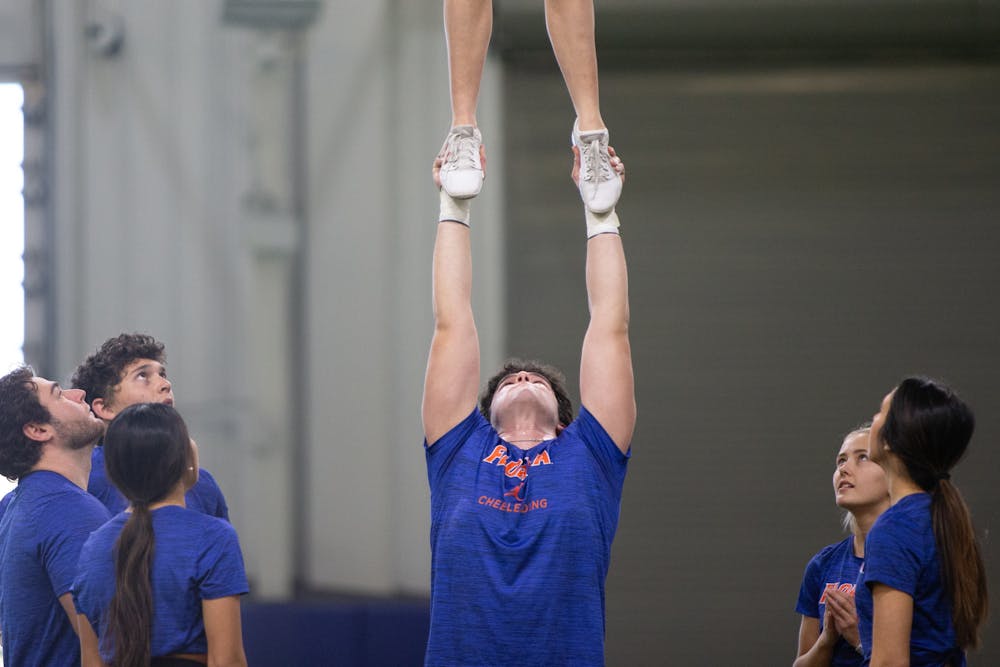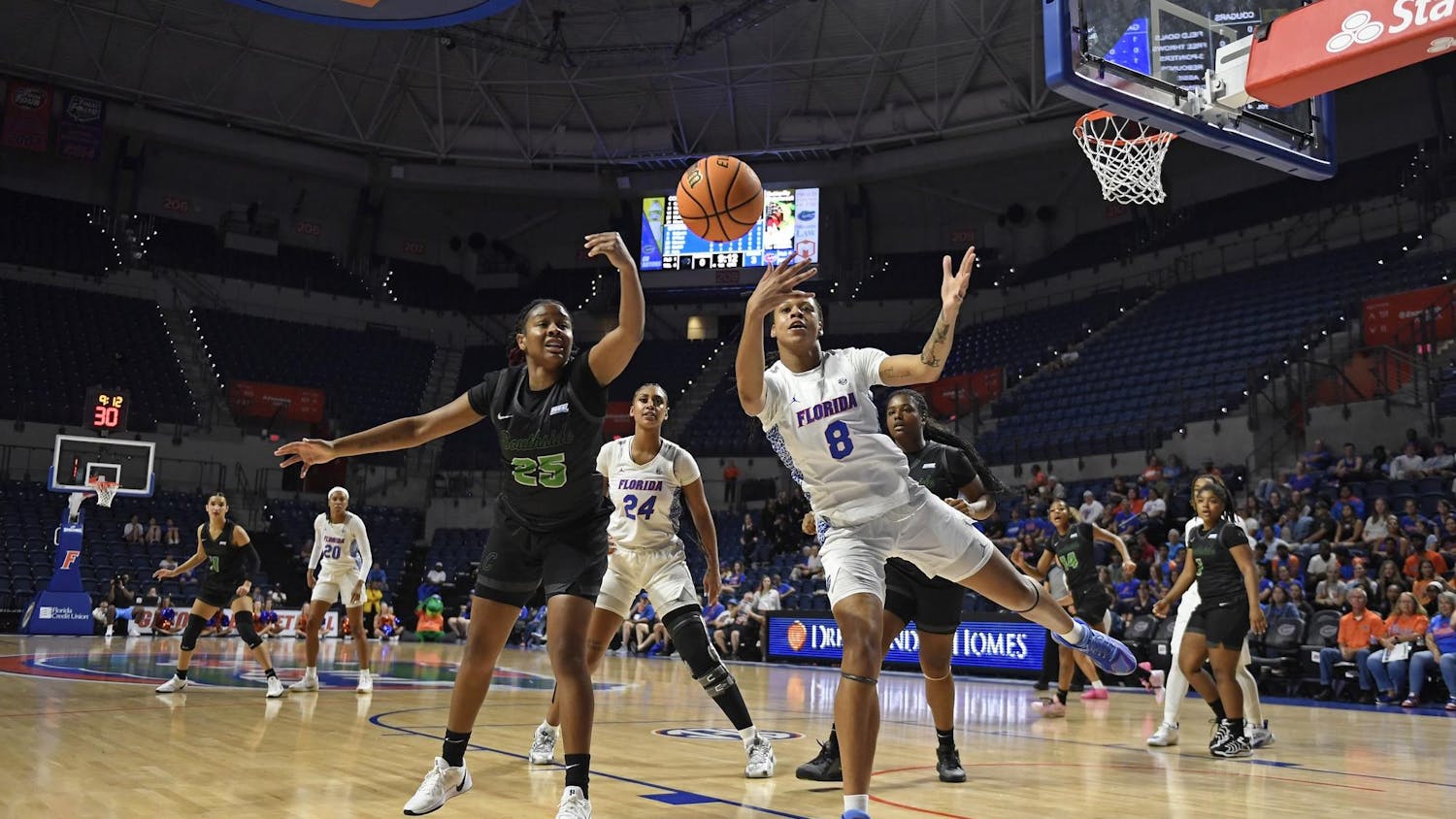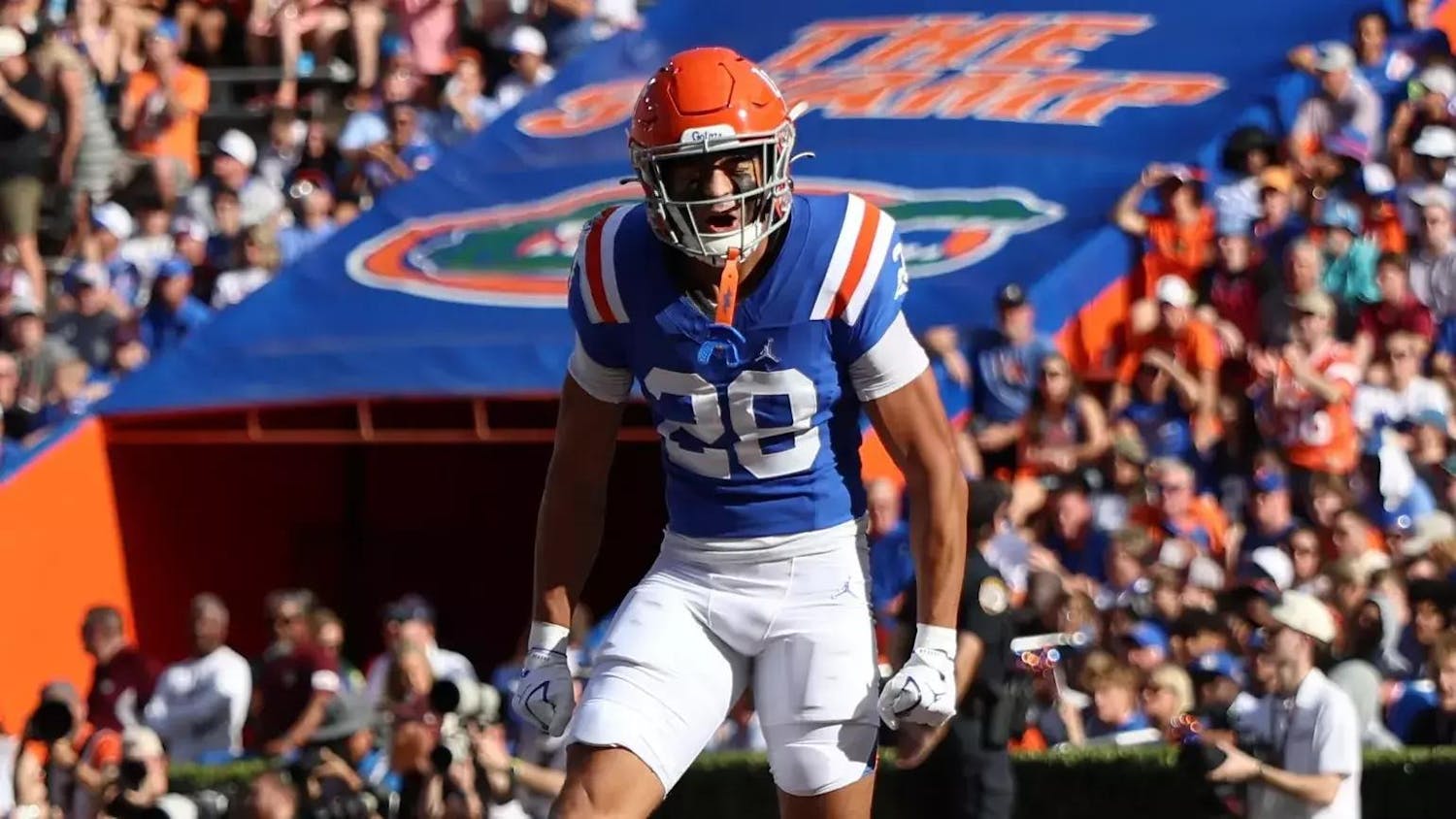To the untrained ear, the orders Sawyer Bailey barked to his team during its 8 a.m. Tuesday practice sounded more like Disney Channel song lyrics than athletic advice.
“Spirit until it’s your turn to pop,” the UF interim spirit squad director called to the bleary-eyed, Nike-clad cheerleaders lining the turf of the indoor football practice facility. “Give me some bump ‘n goes.”
The athletes spent most of the two-hour practice preparing for next month’s cheer tryout, during which they’ll do their best to recruit talented newcomers — and show up themselves to re-earn their spots on the team.
But tryouts will be less competitive for some than others.
Women must do a no-handed backflip just to audition. Men, meanwhile, only need a handstand and a roundoff — a cartwheel where both feet land on the ground at the same time.
Women who attend the pre-tryout prep clinics must shell out a $75 entry fee. Male students from local high schools only pay $25, and male UF students won’t have to pay at all.
Free clinics and limited tumbling requirements are some of the team’s biggest recruiting tools for male athletes, who try out in lower numbers than females, Bailey said.
The team currently has 13 men and 24 women, divided into a combination of male-female stunt pairs and all-girl groups.
Fighting stereotypes with spirit
The assumed connection between cheerleading and femininity has long contributed to society’s perception of male cheerleaders as gay. The stereotype leads men to distance themselves from the female-dominated sport, said 20-year-old UF computer science junior Waleed Aref.
“They’re constantly short on guys,” Aref said. “It’s definitely the gay stigma, if I’m being brutally honest.”
Aref, who is nearing the end of his first year on the team, never had to formally try out at all to earn his spot, he said. The former UF club powerlifter wasn’t interested in megaphones or toss-toe-touches until a buddy on the team convinced him to stunt with the athletes in a casual July gym meetup.
Two weeks after Aref’s first session with the cheerleaders, then-head coach Cortnee Gilchrist invited him into her office to offer him a spot on the team.
Before that summer, Aref never realized UF had male cheerleaders because he “was only looking at the girls,” he said. He joined thinking it couldn’t be more difficult than powerlifting.
“Kind of just switching out the barbell for a lady,” he said.
But Aref quickly realized pure muscle wouldn’t get him far, he said. Instead, he’s spent every practice dialing in on technique and learning to trust his partner.
After seven months of twice-weekly practices and subsequent weight room sessions, Aref knows all the basic stunts. His favorite is the “full up,” in which he tosses his partner and catches her as she spins back down.
When people see him walking around campus at 6 feet 2 inches tall, wearing UF Nike merch and holding a water gallon, they often ask what sport he plays, he said. Cheerleading isn’t usually the first trait he shares after meeting someone, but he’s determined to make male cheerleading into a “cool thing,” he said.
As far as the stigma, most men on the team treat the stereotype about their sexualities as a big inside joke, he said.
“During football season, me and a good friend of mine on the team, we’re just walking down out of halftime,” he said. “And some dude out of the stands goes, ‘Who’s that, your f—ing boyfriend?’”
All they could do to the heckler while in their uniforms was look, smile and wave, Aref said.
At the end of the day, Aref doesn’t think the stigma has much truth. Only about four of the 13 men on the team identify as LGBTQ+, the same number as are in fraternities, he said. And they’re all friends regardless.
Despite the occasional harassment — and the brutal heat, which the team counters with “a lot of caffeine, a lot of pain meds” — Aref still regards football as his favorite sport to cheer. He enjoys all of them, from basketball to volleyball, but said the cheerleaders probably have the least to do during gymnastics meets.
“We usually just stunt at gymnastics,” he said. “The girls, it’s not that they’re not allowed to tumble, but they just don’t tumble. They’re like, ‘We’re gonna leave it to the experts.”
UF male cheerleading, a 118-year history
Men at UF have held megaphones long before baseballs, golf clubs or basketballs.
A mysterious student S.A. Sanborn took the mantle of the university’s first-ever cheerleader when the UF football team beat Rollins College in October 1906.
“Mr. S. A. Sanborn, leader of yells and college songs, stood in the middle of the group and loosed his lusty lungs through the magnificent medium of a massive megaphone,” reported the local University News.
The UF spirit squad, like the student population, was all-male in the following decades, as universities nationwide considered cheerleading a masculine endeavor. The tide changed in the early ‘40s, when girls began joining due to few other athletic options.
The first regular female cheerleaders joined the UF squad in 1938, about 13 years after the first woman enrolled at the university. Eight years later, a cheerleading announcement in The Alligator reported seeking five men and four women.
By the time Steve Nouss joined the team in 1977, being a male cheerleader was cause for much “ribbing” from his friends, he said.
The 69-year-old South Florida chief financial officer originally enrolled at UF to play junior varsity football. But after dropping the sport his sophomore year, Nouss decided to give cheerleading a try at the encouragement of his sorority friends.
By his senior year, Nouss was an All-American cheerleader who led his team to a runner-up finish at the national collegiate cheer championships in California.
His former football teammates originally gave him a hard time, but they were more supportive after realizing the benefits of a friend on the sidelines, he said
“They liked the idea of getting to meet some of the cheerleaders,” Nouss said.
During his captainship, Nouss expected every guy on the team to have a back handspring, he said. Though no longer required today, tumbling remained an expectation for the university’s male cheerleaders throughout the ‘80s, said Alex Place, a 1987 UF alumnus.
“We would be doing different cheers, and some of them would end up with the guys all doing a back tuck,” said the 60-year-old employee benefits consultant. “Man, that was scary trying to learn how to do that. And once I did learn it, I just would do it all the time. At parties. I just thought it was so cool.”
Place was also the butt of more than a few jokes about his cheerleading career, most of which he thinks came from a place of deep-down jealousy on the jokers’ parts. The teasing continued after college when he joined the Marine Corps, he said.
“My call sign was ‘Rah Rah,’” he said. “I had a buddy in my squadron who was a cheerleader at the University of Kentucky, so we got a lot of joking around.”
Place’s original reaction to a fraternity brother suggesting he join the cheer team was that it just wasn’t a “male thing to do.” But now, he reflects on his two cheer years as a college highlight and the source of lifelong friendships like the one he maintains with his former cheer partner, Valerie.
Memories from his cheerleading days still surround Place. His old megaphone has a display spot of honor in his office. He wears the 35-year-old cheerleading sweatshirt with his name on it to bed. And he still keeps tabs on the cheerleading world, UF and otherwise.
“If I'm flipping through the channels on a Saturday, and there's a cheerleading competition on one of the ESPN channels, I will stop and watch that for a good 20 minutes,” he said.
Today’s spirit squad: no feuds, just family
Cole Baggett, a 20-year-old UF animal sciences senior, joined cheer as a sophomore after doing wrestling his entire life. Now in his third year on the team, he credits the people he’s met as the reason he’s stuck around, he said.
The entire team is family, but Baggett has a special connection with his cheer partner Paris Richardson, a 22-year-old UF health administration master’s student.
Though stunt partner couples typically change annually, Baggett and Richardson have been partners since Baggett’s first year and have grown into a “well-oiled machine,” he said.
Though Baggett leaves the dancing to Richardson and the other girls — he’s happy with a megaphone over pom-poms, and no one wants to see most of the men try to dance, anyway, he said — he still thinks both genders have an equal job.
“A lot of times the girls will make fun of us for saying we just clap behind them and throw a stunt every once in a while,” he said. “But we’re throwing them just as much as they’re tumbling.”
His partner, Richardson, confirmed she doesn’t resent the guys for having an easier time at tryouts. The team doesn’t have room for ill will when they need trust on both sides to perform risky stunts, she said.
“It’s brother-sister vibes,” she said.
The cheerleaders also denied any feud with the Dazzlers, the official UF dance team that can be seen pom-pomming up the sidelines alongside the cheerleaders on game days.
“I don’t think there’s any beef,” said Tyler Southard, a 22-year-old UF education sciences junior. “When we get to see [the Dazzlers], we are their biggest fans, and I think they’re the same for us.”
Southard is one of the few male UF cheerleaders with experience in the sport. As a nine-year cheerleader, Southard knew he wanted to join the UF team when he transferred from Northwest Florida State College this year.
Though Southard “didn’t know the slightest thing about football” before coming to UF, it’s now his favorite sport to cheer — although the athleticism of the players on the field doesn’t overly impress him.
“The football team’s throwing a ball, and if they don’t catch it, nothing happens,” he said. “We’re throwing humans.”
Cheerleading should be considered a sport just as much as every other athletic endeavor covered under the UF University Athletic Association, he added.
The age-old question: Is cheerleading a sport?
The UAA currently denies cheerleading varsity sport status, and the team no longer attends competitions like the UF cheerleaders of the ‘70s and ‘80s.
In an unpopular 2012 decision, the UAA “grounded” UF cheerleaders, banning them from doing acrobatic stunts and tumbles, many of which are required at a competitive level. The decision came after an Orlando Magic cheerleader lost her footing and fell on her head during a basketball game, resulting in three fractured vertebrae.
Today, the UF team’s stunts remain restricted. Their nickname, the “chair-leaders,” comes from the fact men can only lift their partners by their glutes.
The cheerleaders aren’t allowed in the athlete’s dining hall, and they can’t receive athletic scholarships until they’ve already enrolled at the university.
But coach Sawyer Bailey appreciates, rather than resents, the UAA’s restrictions, he said. Bailey has known his sport’s dangers all too well ever since his first time cheering.
“I’ll never forget, I was in our high school library,” he said. “Some of my friends who were cheerleaders were stunting right outside, getting ready for practice, and they’re like, ‘Hey, Sawyer, can you come out here and spot us?’”
Bailey’s friends interpreted his response — ”What’s that?” — as a sign of enthusiasm, and in a few minutes he found himself on the base of a stunt group.
“When I went to go catch the girl’s leg when she jumped in, I got kneed in the face and got a bloody nose,” Bailey said. “For whatever reason, I was sold. I was like, ‘This is great.’”
Now in his first year as UF interim spirit director, Bailey is already restyling the program to account for the gender gap at tryouts. Beginning next year, the team will have one coed group and one all-girl group, rather than two mixed teams. An all-female team will create more slots for the many girls who try out, Bailey said.
Bailey will also take any opportunities to educate the UAA on what stunts the cheerleaders can add to their repertoire and consider bringing back competitive UF cheer sometime in the future, he said.
But for now, Bailey remains focused on promoting the sport to UF men, whose eagerness to join and love for the university is more important than having their standing back handsprings, he said.
“Would we love them all to have flips? Absolutely,” he said. “That's a long-term goal that we're working towards, but for the most part at Florida, we want boys who love the Gators.”
If his athlete’s commitment to spirit, directed in equal measures to the blank wall of the indoor practice facility and to 90,000 football fans, remains the same in the years and teams to come, Bailey will have nothing to worry about.
Contact Zoey Thomas at zthomas@alligator.org. Follow her on X @zoeythomas39.

Zoey is the Fall 2025 engagement managing editor of The Alligator. She has previously served as data editor and reported on the university, metro and enterprise desks. Over the summer, she interned for the Orlando Sentinel. Zoey inherited her mom's love of strong coffee and her dad's love of "Buffy the Vampire Slayer."






